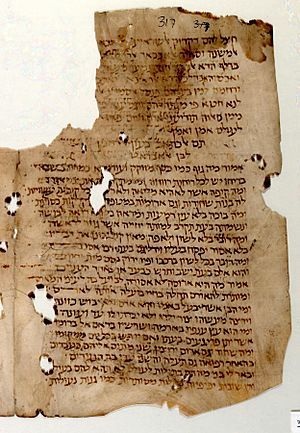Riddles of Dunash ben Labrat facts for kids
The riddles of Dunash ben Labrat are some of the very first Hebrew riddles ever written down. Dunash lived a long time ago, from about 920-925 CE until after 985 CE. He was a very important writer who helped create a new style of Hebrew poetry. This style was inspired by Arabic poems and was popular in a place called Al-Andalus (modern-day Spain and Portugal).
Unlike some other poets, Dunash liked to write riddles about everyday things. He got ideas from many Arabic riddles that were popular at the time. His riddles were written in a special rhythm, like a song.
Contents
Where We Found the Riddles
We know about Dunash's riddles because they were found in three old manuscripts. A manuscript is a handwritten book or document. These special old papers help us learn about history!
- One manuscript is in a city called Saint Petersburg.
- Another is in New York, at the Jewish Theological Seminary. It has at least two riddles that are also found in the Philadelphia paper.
- The third is a small piece of paper from a huge collection called the Cairo Geniza. This piece is from between the 10th and 12th centuries CE. It is kept in Philadelphia, at the University of Pennsylvania's Center for Advanced Judaic Studies Library.
Each of these manuscripts has some riddles that are also in the others, but they also have unique ones. All together, a scholar named Nehemya Aluny thought that 16 riddles could be from Dunash.
Try to Guess! Some Examples
One of the most famous collections of Dunash's riddles is found in the Philadelphia manuscript. It's like a single long poem with ten riddles! Let's look at a few examples. Can you guess the answers?
Riddle 1
This riddle asks about something that looks like "refined silver" and tastes like "refreshing ambrosia" (a sweet, delicious food). It has a lovely smell that spreads everywhere. And its sweet "waters" can quench your thirst.
What do you think it is?
- It's an apple!
Riddle 2
This riddle describes a "capsule" that is never completely full or empty. All of them look similar. Inside, it has "black and red daughters." The outside is covered with a "green shell."
What could this be?
- It's a watermelon!
Riddle 3
This riddle talks about something that "cries without tears." It "shows everything" but "does not see its own clothing." When it's about to "die," it comes back to life as soon as its "head is cut off."
Any ideas?
- It's a wick (like in a candle)!
Riddle 4
This riddle describes something that "speaks without a tongue or mouth." It makes sounds without a voice. It can make its owners "limp" or "leap" without needing ropes or ties.
What is it?
- It's a pen! (It makes words, which speak, and can make people write quickly or slowly).
Riddle 8
This riddle asks about a "tree" that has its "branches in the earth." But its "roots" were made by God in the "heavens." It gives "pleasant fruit" at the right time. And it can be "uprooted" every single day.
This one is a bit tricky!
- It's the sun! (Its rays are like branches on Earth, its source is in the sky, it provides light and warmth like fruit, and it "rises" and "sets" every day).


